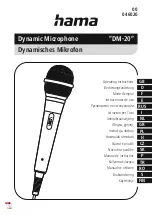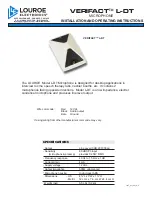
52
Sabine Smart Spectrum
®
Wireless
© 2011 Sabine
, Inc.
As an example of the power of FBX, figure 15b shows test results measured
with a PA set up consisting of a microphone, mixer, FBX Feedback Extermina-
tor®, power amp and two speakers. The system’s gain was first raised until the
FBX removed nine feedback points. Next, the FBX was replaced with a graphic
EQ. The EQ was adjusted while the system gain was raised to the same level
achieved with the FBX. The frequency response curves of each device were
then plotted and are compared in figure 15b. Note how much more of the pro-
gram (the “good audio”) is eliminated using an EQ — whereas only feedback is
eliminated using FBX filters.
15.3. Parametric Filters and FBX
Of course, many savvy sound engineers, realizing the limitations of graphic
equalizers in removing problem feedback, prefer to use a different type of equal-
izer, called a parametric EQ, for such applications. If you’re one such audio
engineer, you’ll be comforted to know that FBX filters share much in common
with parametrics.
Compared to graphic filters, parametrics allow more precise adjustments — spe-
cifically, control of filter width, the amount of boost or cut, and the mid-band
frequency of the filter. This greater precision, however, comes at a price, as para-
metric filters are not nearly as intuitive or simple to use as graphic equalizers.
Nothing, however, is easier to use than an FBX filter, which enjoys the precision
of a parametric filter, yet deploys instantly and automatically whenever feedback
is detected. Effectively, an FBX filter is a parametric filter set to a tenth-octave
width, restricted to cut-only activity, and automatic in its choice of frequency
band. If you want hands-on control, use the Sabine True Mobility® Remote
Software to change FBX filters to parametrics, and tweak frequency, width, and
depth to your liking.
Sabine Constant Q Filters
It is common to describe a filter’s quality factor, or “Q,” as the center frequency of the filter divided by the filter width (in Hertz) measured
at the -3dB point. Filters that have the same Q, or width, at the -3dB point regardless of the filter’s cut or boost are called Constant Q
filters (see Fig. 15b). Filters that get wider as the filter gets deeper are called Proportional Q filters (see Fig. 15c). Lately, however, the
definition of Constant Q is becoming less distinct. Many equalizer manufacturers claim their equalizers have Constant Q filters, when
in fact they get substantially wider as they get deeper. The only way to know for sure if the filters are truly Constant Q is to inspect their
frequency response curves. Sabine FBX Filters are true Constant Q filters.
Fig. 15b - Constant Q Filter
Fig. 15c - Proportional Filter
FBX Theory & Practice
Summary of Contents for SWM7000 -
Page 2: ......













































